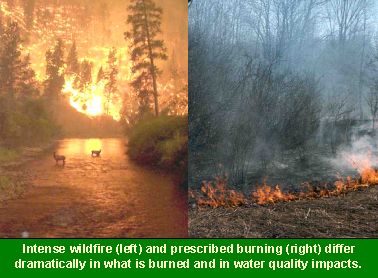7. Fire Management*
*Note: BMPs outlined below are examples. Check with the appropriate state agency to determine applicable BMPs in your area.
Fire is an important tool in forest management and a natural occurrence that sometimes requires control or suppression. Practices for protecting water quality relate to two general categories of fire management: wildfire control and prescribed burning.
Prescribed burning reduces slash, competition for nutrients among seedlings, and fuel for wildfires. Where tree species are ecologically dependent on fire for regeneration, fire also serves as an essential forest management tool. Periodic, low-intensity prescribed fires usually have little effect on water quality, and revegetation of burned areas reduces sediment yield from prescribed burning and wildfires.
The intensity and severity of burning and the proportion of the watershed burned are the major influences on streamflow and water quality. Fires that burn intensely on steep slopes close to streams and that remove most of the forest floor and litter down to the mineral soil are most likely to affect water quality by increasing sediment and nutrient pollution in the water. Simultaneously, intense fires decrease soil nutrients and increase soil erosion.
![[logo] US EPA](https://www.epa.gov/epafiles/images/logo_epaseal.gif)
